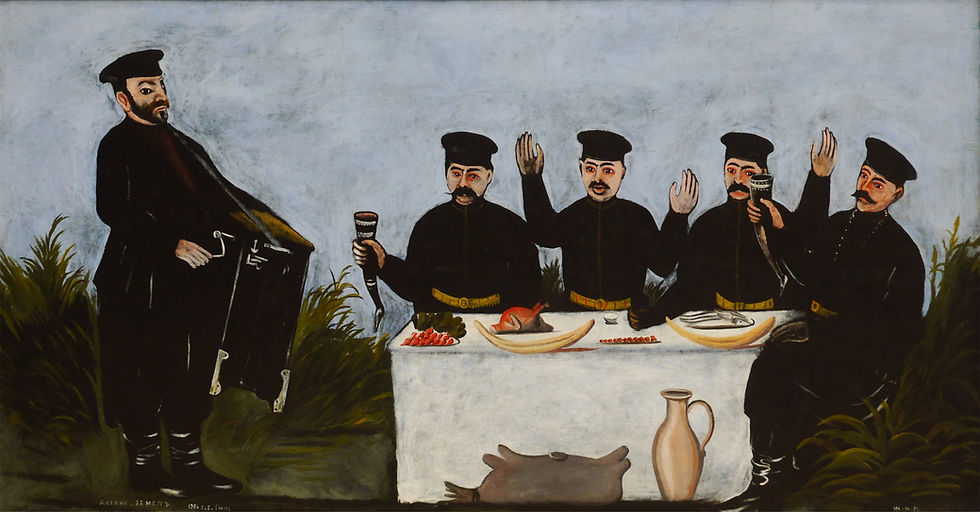- Shawn Basey

- Jan 26, 2019
- 4 min read

When you’re living in a city, you often don’t get what’s so interesting about that city, or what draws you in. I’ve met New Yorkers who have never seen the Statue of Liberty, Wyomingites who have never seen Yellowstone, and a ton of Tbiliselis who haven’t been to a single Tbilisi museum. For good reason, for the recent history after the fall of the Soviet Union, one might have asked, “What museums?” But now, some 30 years later, the cosmopolitan culture of this jewel of the Caucasus is starting to blossom again. Many of the museums are opening back up and showcasing the wonders of Georgia.
Pirosmani
One past wonder was a naïve painter known as Nikala Pirosmani. With premiere exhibitions having hit Europe recently, he’s definitely Georgia’s most famous painter. Born as Nikoloz Pirosmanashvili to a family of poor shepherds in Mirzaani, a small village out on the southern slopes of Kakheti, just before the lush wine-lands turn into mud volcanoes and grass steppes. His parents died while he was still a child, and with his two older sisters he moved to Tbilisi, where he would soon take up residence under a staircase as a servant to rich folks. There he learned to read Georgian and Russian, and taught himself how to paint.
His painting was never a success in his life – as per usual. For the most part, he made his money making portraits and signboards (akin to the modern artist who has to make their money from graphic design and web banners) and doing odd jobs like house painting and whitewashing. He also commonly painted murals and other pictures for local bars and restaurants.
Check out my t-shirt designs at teepublic:
That’s where he was “discovered”. Two well-known painter brothers, Kirill and Illia Zdanevich, came across him while painting in one such restaurant. They thought his bizarre and jovial style was fascinating, and immediately sent a letter off to the Russian newspaper, Zavkazskaia Rech and got some of Pirosmani’s works included in a naïve gallery showing in Moscow.
For the whole of Pirosmani’s life, that was his ten minutes of fame. The Society of Georgian Painters did try to invite him to their meetings and bring him into the artists’ fold, but as a poor shepherd from the country he always felt out of place and a bit strange around other artists. He remained poor and relatively unknown, his room under the stairs dark, dirty, and dank. As World War I was ongoing and raging on the frontier of Georgia, there was little sign of relief. He wouldn't live to see the end of the war: in April 1918 he died of liver failure.
Pirosmani’s Apartment
Pirosmani’s apartment is almost exactly how he left it a century ago. It sits on a quiet street just near the central train station in the Chugureti neighborhood, still under the stairs of an apartment. They’ve made a sort of museum out of it, and for five lari you can come in and have a look. They expanded it by a room to allow an exhibit of some prints of his paintings, and an old lady shows you around and tells you about his life. She seems quite excited to have visitors, as I imagine few ever come – the museum isn’t advertised, there’s no clear sign, and the lady doesn’t speak anything but Georgian and Russian.

Inside Pirosmani's apartment
The apartment has little light and is quite musty. For a student needing a place to stay for a couple of years, it would seem fine, but for a man to spend most of his life… there was barely enough room to store clothes, have an easel, a small table, and a bed. There was no fire pit to stay warm, though perhaps he had a small wood stove as most still rely on in the city today. There were two doors: one from the main hall and one that led to the backyard, where the shared toilet would have been. Definitely not enough room for all the women every artist dreams of. That’s the whole of the museum.

The artist's bed
The lady told us about a more extensive and interesting museum out in the village Mirzaani, in the house where he had grown up. I was wanting to write this blog after that visit, but I decided that will have to wait (maybe I’ll add on to this blog later). Most of his works are featured in two museums: one in Sighnaghi (the main tourist hub not far from Mirzaani) and the other in the Georgian National Museum on Rustaveli.

the door to the artist's room
The Georgian National Museum
From the small apartment we made our way across the city up to the Museum of Fine Arts on Rustaveli.
The Museum is situated next to the Kashueti Church, a church renown for its murals by the famous Georgian painter Lado Gudiashvili (stay tuned for a future blog on the early Soviet era painter). The bottom floor is a rather large exhibition space for touring pieces, and the top floor is dedicated to local historical artists, namely Gudiashvili, Elene Akhveliani, and Pirosmani. The website doesn’t tell you much and the information on the artists and movements is rather limiting there, but at least you get to see a few fine pieces.
Two of his pieces in the museum:

A Georgian feast

A festival in Bolnisi














